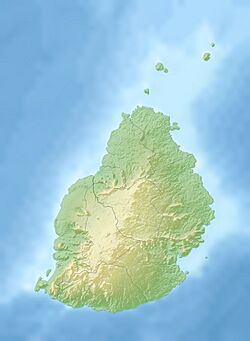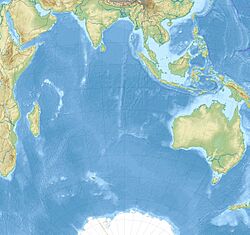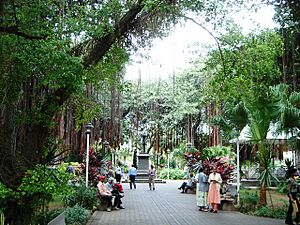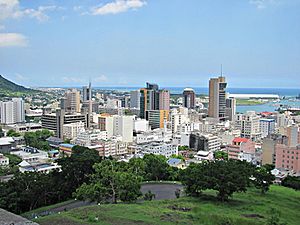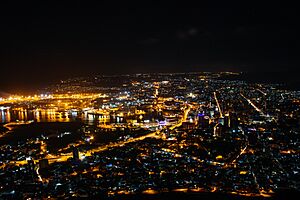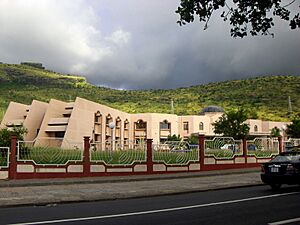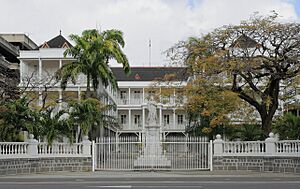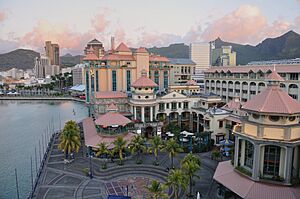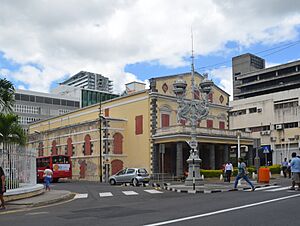Port Louis facts for kids
Quick facts for kids
Port Louis
|
|||
|---|---|---|---|
|
Capital city
|
|||
|
Port Louis Waterfront
Champ de Mars
Aerial view of Port Louis
Port Louis Harbour
|
|||
|
|||
| Motto(s):
"Concordia et Progressio"
(Latin for "Harmony and Progress") |
|||
| Country | |||
| District | Port Louis District | ||
| Founded | 1638 | ||
| Town | 25 August 1966 | ||
| City | 12 December 2011 | ||
| Government | |||
| • Type | Municipality | ||
| Area | |||
| • Total | 46.7 km2 (18.0 sq mi) | ||
| Population
(2018)
|
|||
| • Total | 147,066 | ||
| • Rank | 1st in Mauritius | ||
| • Density | 3,149/km2 (8,156/sq mi) | ||
| Time zone | UTC+04:00 (Mauritius Time) | ||
| • Summer (DST) | (Not Observed) | ||
Port Louis (French: Port-Louis, Mauritian Creole: Polwi or Porlwi) is the capital and biggest city of Mauritius. It is mostly in the Port Louis District, with a small part in the Black River District. Port Louis is the main place for business and government in the country. The city is managed by the Municipal City Council of Port Louis. In 2018, about 147,066 people lived there, making it the most populated city in Mauritius.
Contents
History of Port Louis
Port Louis was first used as a harbor by Dutch settlers in 1606. They called the area Harbour of Tortoises. In 1736, when the French ruled, it became the main city of Mauritius. It was an important stop for French ships traveling between Asia and Europe around the Cape of Good Hope.
The city was named after King Louis XV. At that time, Mauritius was known as Ile de France. The French governor, Bertrand-François Mahé de La Bourdonnais, helped the city grow a lot. Port Louis was chosen for the main harbor and fort because the Moka Mountain Range protected it from strong winds during cyclones.
The port remained important when the British took over during the Napoleonic Wars (1800–15). It helped Britain control the Indian Ocean. However, fewer ships visited after the Suez Canal opened in 1869. When the Suez Canal was closed for seven years (starting in 1967), port activity increased again. The port was updated in the late 1970s. This helped it stay important for all imports and exports from Mauritius.
Port Louis is still the business and government center of Mauritius. In the late 1990s, tourism grew, leading to many new shops, hotels, and restaurants in the Caudan Waterfront area. Artist Raouf Oderuth showed what the waterfront looked like in the 1930s. Back then, there were hardly any cars. Today, Place D’Armes is still recognizable, even with tall buildings and busy traffic.
Climate and Weather
Port Louis has a tropical savanna climate. This means it has a wet season and a dry season. The wettest months are from December to April, with at least 80 mm (3.1 in) of rain. The rest of the year is the dry season.
The city's temperatures do not change much throughout the year. The coolest temperatures are in the middle of the year, with average high temperatures around 27 °C or 80.6 °F. During the wet season, the city gets its hottest temperatures, with average highs around 31 °C or 88 °F.
| Climate data for Port Louis | |||||||||||||
|---|---|---|---|---|---|---|---|---|---|---|---|---|---|
| Month | Jan | Feb | Mar | Apr | May | Jun | Jul | Aug | Sep | Oct | Nov | Dec | Year |
| Mean daily maximum °C (°F) | 31.5 (88.7) |
31.4 (88.5) |
31.5 (88.7) |
30.7 (87.3) |
29.3 (84.7) |
27.6 (81.7) |
26.7 (80.1) |
26.8 (80.2) |
27.7 (81.9) |
28.8 (83.8) |
30.2 (86.4) |
31.1 (88.0) |
29.4 (85.0) |
| Daily mean °C (°F) | 27.8 (82.0) |
27.7 (81.9) |
27.7 (81.9) |
26.9 (80.4) |
25.4 (77.7) |
23.8 (74.8) |
23.0 (73.4) |
23.0 (73.4) |
23.6 (74.5) |
24.6 (76.3) |
26.0 (78.8) |
27.2 (81.0) |
25.6 (78.0) |
| Mean daily minimum °C (°F) | 24.1 (75.4) |
24.0 (75.2) |
23.8 (74.8) |
23.0 (73.4) |
21.5 (70.7) |
19.9 (67.8) |
19.3 (66.7) |
19.1 (66.4) |
19.4 (66.9) |
20.4 (68.7) |
21.8 (71.2) |
23.2 (73.8) |
21.6 (70.9) |
| Average rainfall mm (inches) | 131 (5.2) |
160 (6.3) |
83 (3.3) |
87 (3.4) |
48 (1.9) |
24 (0.9) |
18 (0.7) |
19 (0.7) |
17 (0.7) |
15 (0.6) |
24 (0.9) |
85 (3.3) |
711 (27.9) |
| Average rainy days (≥ 1.0 mm) | 9 | 10 | 8 | 7 | 6 | 4 | 4 | 5 | 3 | 3 | 3 | 6 | 68 |
| Mean monthly sunshine hours | 248 | 226 | 217 | 240 | 248 | 210 | 217 | 217 | 240 | 279 | 270 | 279 | 2,891 |
| Source 1: World Meteorological Organization. | |||||||||||||
| Source 2: BBC Weather | |||||||||||||
Economy and Business
The economy of Port Louis mainly depends on its financial services, port, tourism, and factories. These factories make things like textiles (cloth), chemicals, plastics, and pharmaceuticals (medicines). Port Louis has the biggest port in the Indian Ocean and is one of Africa's main financial centers.
Financial Services
Port Louis is the financial heart of Mauritius. The country is known as a safe place for business because it has a strong democracy, a stable government, and people who speak many languages. The Stock Exchange of Mauritius is located here.
Port Louis also has many banks that serve both local and international customers. There are also insurance companies, pension funds, and foreign exchange dealers. The oldest bank in Port Louis is the Mauritius Commercial Bank, started in 1838. The Bank of Mauritius is the country's central bank. The Bank of Mauritius Tower is the tallest building in the country, standing 124 m (407 ft) tall.
Transportation in Port Louis
Port Louis has two main bus stations. Victoria Station serves buses from the eastern and southern areas, and the Plaines Wilhems district. Immigration Square, also called Gare du Nord, is for buses coming from the northern districts of Pamplemousses and Rivière du Rempart. Many buses also connect the city to nearby suburbs.
Most streets in Port Louis are in a grid pattern, and many are one-way. While roads are generally good, many streets are narrow, typical for an old colonial town. Because many people come to Port Louis for work, traffic can be very heavy during the day. Finding parking can be difficult.
To help with traffic, the government has planned a light rail transit system. Other ideas include moving some government offices out of Port Louis or having flexible work schedules. An office complex called Ébène has already been built south of Port Louis to help move workers. A new ring road on the east side of Port Louis is also expected to reduce traffic. A bridge, sometimes called the "Dream Bridge," is also being built over the Port Louis harbor to help with traffic.
Light Rail Transit System
In 2012, the government decided to build a rail system about 25 km long between Curepipe and Port Louis. This idea had been thought about for almost 30 years. The project started with an agreement between the governments of Mauritius and Singapore.
Construction for the light rail system began in late 2017. The contract was given to an Indian company, Larsen & Toubro. The first part of the Mauritius Metro Express, from Port Louis to Rose Hill Central, opened in January 2020. The second part, which goes to Curepipe, opened in October 2022.
Port Facilities
Port Louis is home to Mauritius's main harbor. It is the only official entry and exit point for ships in the country. All ships must get clearance here before visiting any other part of the island nation by sea.
The Mauritius Ports Authority (MPA) manages the port. It provides the port's buildings and equipment. It also works with private companies for cargo handling and promotes the port's growth. The harbor is next to the main city and has three terminals.
- Terminal I has over 1,180 meters of quay (a dock where ships load and unload). It has six spots for cargo, passengers, and fishing boats.
- Terminal II has 986 meters of quays with six spots. It has special areas for handling and storing sugar, fish, and other goods. There is also a special 124-meter cruise ship jetty (a pier for ships).
- Terminal III has two 280-meter quays, each 14 meters deep. It is designed for large container ships. It has big cranes to move containers. There are also storage areas for ethanol and connections for refrigerated containers.
Ships that are too big to dock can anchor in the Outer Anchorage, which is still part of the port. In 2010, over 2,200 ships visited the port each year. In 2019, the port could handle 1 million TEUs (a measure for cargo containers). Overall, the port adds 2% to the country's economy.
The cruise ship terminal opened in 2010. It shows how important tourism is becoming to Mauritius. It can handle cruise ships up to 300 meters long. It was the first facility in the Indian Ocean that could handle the world's largest cruise ships. In 2012, over 11,510 tourists arrived by cruise ship.
You can also find places to dock smaller boats at the Caudan Waterfront. There are 20 berths with electricity and water. They also offer showers, laundry, and parking. Boats up to 30 meters long can be accommodated.
The National Coast Guard facility is also located at the port.
Airport Access
Port Louis is served by Sir Seewoosagur Ramgoolam International Airport. This is the main airport for Air Mauritius. Other airlines like Air France, Emirates, Saudia, and Turkish Airlines also fly there.
Education in Port Louis
Port Louis has both government-run and private primary and secondary schools. Most private schools get a lot of help from the government. The government pays staff wages and helps with operating costs. Students and their families pay for things like books and uniforms. The government also gives loans to private schools to help them improve their buildings.
Some schools are run by MEDCO (Mauritius Educational Development Company). This is a partnership between the Government of Mauritius and the State Investment Corporation.
Port Louis has many secondary schools, including Alpha College, Bhujoharry College, Labourdonnais College, and Royal College Port Louis. The government also runs a vocational school for boys called Immaculee Conception SSV.
The main university in Port Louis is the University of Technology, Mauritius. It is a public university that focuses on technology. The École de Medecine Louis Pasteur helps students prepare for medical studies in France. Several technical schools are also in the city. These include the Jhurry Rya School for information technology and Appavoo Business School.
Architecture and Buildings
The city has many buildings and monuments that show its rich history. Near the city center, you can find French colonial buildings from the 1700s, like the Government House. Other important old buildings include the Jummah Mosque, the English Saint James Cathedral, the Indian Tamil Temple, and the beautiful Port Louis Theatre. The Champ de Mars Racecourse and a Chinese Pagoda are also nearby.
You can still see some old houses from the past. They are often made of wood with special windows and large porches. However, many historic buildings are not in good condition. They are being replaced by new homes and businesses made of concrete and glass. The city now has many modern high-rise buildings.
Chinatown
The Pagoda is a key part of Port Louis's Chinatown. This is one of several Chinatowns in Africa. A large "friendship" gate marks its entrance, just east of the Central Market. This area was traditionally where the Chinese community lived and had their shops. Most of them were descendants of the Hakka Chinese, who first came to Mauritius in 1826.
Today, Chinatown is home to a more diverse community. But it still keeps its original look with many small shops and restaurants. Its old buildings and Chinese pagodas stand next to the city's modern business buildings. The Chinese Chamber of Commerce, founded in 1908, hosts a popular food and cultural festival every April or May.
Culture and Arts
Port Louis has always been a lively cultural city. It has attracted painters, poets, and writers for centuries. Marie-Thérèse Humbert wrote her famous novel, La Montagne des Signaux, with Port-Louis in mind. Malcolm de Chazal, a Mauritian writer and painter, was often seen in the capital.
Poet and semiologist Khal Torabully, who was born in Port Louis, helped create the Travellers' Lane at the Jardin de la Compagnie. He also designed the Parcours Culturel with sayings from Malcolm de Chazal, right in front of the famous Port Louis Theatre. This theater is still used for classical music, jazz, and local plays. It has a long history, including the first opera performances on the island in the 1800s.
More modern entertainment in Port Louis includes several cinemas. Most films are shown in French and English. The modern Swami Vivekananda International Convention Centre recently opened in Pailles, a suburb of Port Louis. It is the first facility of its kind in Mauritius. It is used for conventions, concerts, and trade shows.
English is currently the official language of Port Louis and Mauritius.
Museums to Visit
- The Blue Penny Museum is at the Caudan Waterfront. It tells the story of the island's history and art. It has old marine maps, paintings, sculptures, and famous stamps, including the rare one-penny and two-pence stamps.
- The Natural History Museum of Port Louis shows the amazing animals of Mauritius. It has sections on birds, land animals, marine species, and the dodo, a famous Mauritian bird that is now extinct.
- The Mauritius Postal Museum is in an old stone building from the 1700s. It displays stamps and postal items from Mauritius and around the world.
- The Mauritius Photography Museum is a private museum in a small 18th-century French colonial building. It shows old photos and documents about photography and early movies in Mauritius.
- The Aapravasi Ghat is what remains of an immigration center. It was built by the British to bring workers from India, Africa, and Asia to work on sugar farms.
- The National Library of Mauritius has a large collection of materials about Mauritius's history. This includes old writings, books, newspapers, music, photos, and maps. It also offers regular library services.
Places of Worship
Port Louis has many different places of worship. The most common are Hindu temples. There are also Christian churches and temples, including the Roman Catholic Diocese of Port-Louis (Catholic Church), the Church of the Province of the Indian Ocean (Anglican Communion), and Assemblies of God. You can also find Muslim mosques.
Sports and Fun Activities
Sports are very popular in Port Louis, just like in the rest of Mauritius. Over 35 sports groups are part of the Mauritius Sports Council. Popular activities include football, volleyball, martial arts (like Karate and Taekwon Do), table tennis, badminton, and pétanque (a game similar to bocce). The Mauritius National Olympic Committee is also based in Port Louis.
Public sports facilities in Port Louis include St. François Xavier stadium, which is used for football. However, most large sports facilities are in the less crowded suburbs and districts around Port Louis.
Football clubs across the country are organized by the Mauritius Football Association. The Port Louis team, called the Association Sportive Port-Louis 2000 (AS Port-Louis 2000), won the national championship in 2003, 2004, 2005, and 2011.
Another popular sport in Port Louis is Thoroughbred horse races. These races are held at the Champ de Mars Racecourse, which is the second oldest horse race track in the world. You can bet on the horse races at the track.
Gambling is also a popular activity in Port Louis. Besides the racecourse, there are four casinos in the city. They offer table games, slot machines, and video poker. The largest casino in Mauritius is the Caudan Waterfront Casino. Other casinos include Le Grand Casino du Domaine, L'Amicale Casino, and the Senator Club.
Cities Port Louis is Connected To
Port Louis has special connections with other cities around the world. These are called "twin towns" or "sister cities":
 Alexandria, Egypt
Alexandria, Egypt Antsiranana, Madagascar
Antsiranana, Madagascar Dakar, Senegal
Dakar, Senegal Doha, Qatar
Doha, Qatar Foshan, China
Foshan, China Karachi, Pakistan
Karachi, Pakistan La Possession, Réunion, France
La Possession, Réunion, France Lamentin, Guadeloupe, France
Lamentin, Guadeloupe, France Maputo, Mozambique
Maputo, Mozambique Port Mathurin, Mauritius
Port Mathurin, Mauritius Pretoria, South Africa
Pretoria, South Africa Saint-Malo, France
Saint-Malo, France
Famous People from Port Louis
- Eugénie Poujade (1814-1881), a writer and poet.
- Élysée Aviragnet (1828-1908), a professor of literature and music.
Images for kids
See also
 In Spanish: Port Louis para niños
In Spanish: Port Louis para niños








